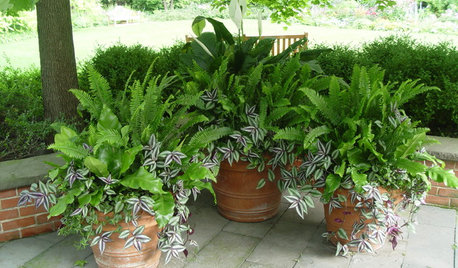Soft Brown Scale on a Boston Fern
trilliumfae
9 years ago
Related Stories

GARDENING GUIDES7 Fabulous Shade-Loving Ferns for Containers
Shade-loving ferns can add color and texture to your container designs
Full Story
COLORPretty Pink Color Schemes, Subtle to Sensational
How do we love pink? Let us count the ways: soft, sassy, with chartreuse and electric blue and, yes, even red ...
Full Story
MY HOUZZMy Houzz: A Cocktail of Industrial and Cozy on Louisville's Whiskey Row
Muted tones and soft textures transform an open loft space into an inviting home
Full Story
DECORATING GUIDESModern Life Makes Room for Blooms
Vintage florals still look lush and lovely on upholstery, curtains, wallpaper and more
Full Story
TRANSITIONAL HOMESHouzz Tour: Room for the Whole Gang in This Cape Cod Home
As homeowners transition to being empty nesters, they expand their summer house to serve extended family year-round
Full Story
BATHROOM DESIGNSweet Retreats: The Latest Looks for the Bath
You asked for it; you got it: Here’s how designers are incorporating the latest looks into smaller master-bath designs
Full Story
KITCHEN DESIGNDream Spaces: 12 Beautiful White Kitchens
Snowy cabinets and walls speak to a certain elegance, while marble counters whisper of luxury
Full Story
DECORATING GUIDESThe Case for In-Between Colors
These mutable hues defy easy description, but their appeal all around the home isn't hard to get
Full Story
COLOR12 Tried-and-True Paint Colors for Your Walls
Discover one pro designer's time-tested favorite paint colors for kitchens, baths, bedrooms and more
Full Story
DECORATING GUIDESKnot Again! Macrame Is Back
It's happened. A craft that typified 1970s style (the owls, the spider plants!) is back, but better
Full Story








ken_adrian Adrian MI cold Z5
trilliumfaeOriginal Author
Related Professionals
Parole Landscape Architects & Landscape Designers · Vernon Hills Landscape Architects & Landscape Designers · Peabody Landscape Contractors · Arlington Landscape Contractors · Broomfield Landscape Contractors · Cambridge Landscape Contractors · Canby Landscape Contractors · Cincinnati Landscape Contractors · Commack Landscape Contractors · La Vista Landscape Contractors · Middleton Landscape Contractors · New Baltimore Landscape Contractors · New Brighton Landscape Contractors · Tinton Falls Landscape Contractors · West Chicago Landscape Contractorsken_adrian Adrian MI cold Z5
trilliumfaeOriginal Author
ken_adrian Adrian MI cold Z5
rhizo_1 (North AL) zone 7
trilliumfaeOriginal Author
calliope
ken_adrian Adrian MI cold Z5
trilliumfaeOriginal Author
calliope
rhizo_1 (North AL) zone 7
ronalawn82
trilliumfaeOriginal Author
rhizo_1 (North AL) zone 7
calliope
ken_adrian Adrian MI cold Z5
rhizo_1 (North AL) zone 7
calliope
rhizo_1 (North AL) zone 7